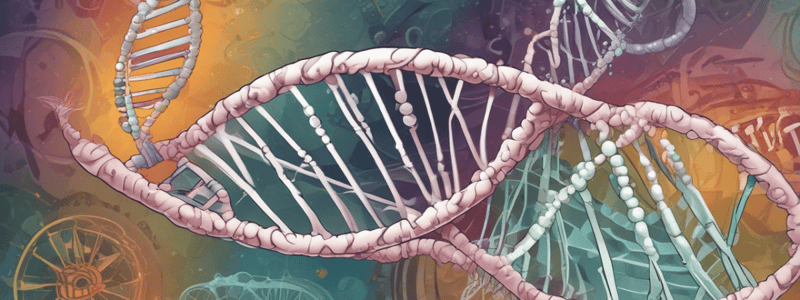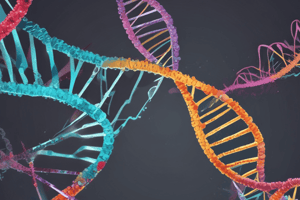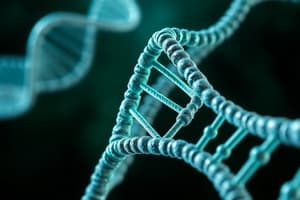Podcast
Questions and Answers
What was labeled with phosphorous in the Hershey-Chase experiment?
What was labeled with phosphorous in the Hershey-Chase experiment?
- DNA (correct)
- Protein
- Carbohydrate
- RNA
Which form of DNA is most common?
Which form of DNA is most common?
- A-form
- E-form
- Z-form
- B-form (correct)
How many hydrogen bonds connect adenine (A) to thymine (T) in DNA?
How many hydrogen bonds connect adenine (A) to thymine (T) in DNA?
- One
- Four
- Three
- Two (correct)
In the Meselson-Stahl experiment, which replication model was confirmed?
In the Meselson-Stahl experiment, which replication model was confirmed?
What is the structure of the DNA backbone?
What is the structure of the DNA backbone?
Which DNA conformation is a left-handed helix?
Which DNA conformation is a left-handed helix?
What type of bond connects two nucleotides in DNA?
What type of bond connects two nucleotides in DNA?
Which of the following is a purine base?
Which of the following is a purine base?
Which sugar is found in DNA?
Which sugar is found in DNA?
According to Chargoff's rule, which of the following statements is true?
According to Chargoff's rule, which of the following statements is true?
Which component is not found in a nucleoside?
Which component is not found in a nucleoside?
What differentiates deoxyribose from ribose?
What differentiates deoxyribose from ribose?
Which of the following bases pairs with guanine (G) in DNA?
Which of the following bases pairs with guanine (G) in DNA?
What does a nucleotide consist of?
What does a nucleotide consist of?
Flashcards are hidden until you start studying
Study Notes
DNA Composition
- Sugars in DNA are deoxyribose and ribose, both 5-carbon sugars, but ribose has an extra hydroxyl (-OH) group attached to the 2' carbon.
- Nitrogenous bases in DNA are pyrimidines (Cytosine, Thymine, and Uracil) and purines (Adenine and Guanine).
- Phosphate in DNA is a negatively charged inorganic ion consisting of one phosphorus atom and four oxygen atoms.
- Phosphate forms phosphodiester bonds with the 5'-carbon of deoxyribose sugar and the 3'-carbon of the preceding deoxyribose sugar.
Nucleosides and Nucleotides
- A nucleoside is a compound composed of a nitrogenous base linked to a 5-carbon deoxyribose or ribose sugar.
- A nucleotide is a nucleoside attached to a phosphate group.
DNA Structure
- Nucleic acids are polymers, and monomers are called nucleotides.
- Nucleotides consist of a base, sugar, and phosphate.
- Bases are either purine (adenine, guanine) or pyrimidine (thymine, cytosine, uracil).
- Sugar is either deoxyribose or ribose.
- Phosphate links nucleotides together.
- The 3' carbon of one nucleotide is linked to the phosphate of another nucleotide by a phosphodiester bond through the 5' carbon of the other nucleotide.
Important Experiments
Chargaff's Rule
- Chargaff's rule states that in DNA, the amount of purine bases is equal to the amount of pyrimidine bases, i.e., [A] = [T] and [G] = [C] but [A + G] ≠ [T + C].
The Hershey-Chase Experiment
- The Hershey-Chase experiment showed that DNA carries genetic information, not protein.
DNA Double Helix
- The double helix has anti-parallel strands with a sugar-phosphate backbone.
- Two hydrogen bonds connect T to A, and three hydrogen bonds connect G to C.
- The sugar-phosphate backbones run anti-parallel to each other, aligning the 3' and 5' ends of the two strands.
DNA Conformations
- The A-form is a short, wide, right-handed helix.
- The B-form is the most common conformation.
- The Z-form is a left-handed helix.
The Meselson-Stahl Experiment
- The Meselson-Stahl experiment showed that DNA replication is semi-conservative, meaning each new strand contains one original and one new strand.
Studying That Suits You
Use AI to generate personalized quizzes and flashcards to suit your learning preferences.




